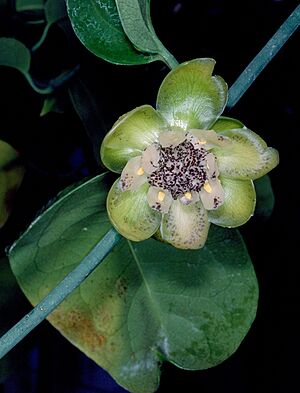Austrobaileya facts for kids
Quick facts for kids Austrobaileya |
|
|---|---|
 |
|
| Conservation status | |
|
Least Concern (NCA)
|
|
| Scientific classification | |
| Synonyms | |
|
Austrobaileya maculata C.T.White |
Austrobaileya is a very special plant genus, like a unique family with only one member! This plant family, called Austrobaileyaceae, is also unique because it contains only this one genus. Think of it as a very old and important branch on the tree of life for flowering plants. In fact, it's one of the most ancient groups of flowering plants on Earth! The only species in this genus is called Austrobaileya scandens. You can only find this amazing plant in the beautiful Wet Tropics rainforests of Queensland, Australia, where it thrives in lush, high-up rainforest areas. Scientists first officially described it in 1933.
Contents
Discovering the Ancient Austrobaileya
Austrobaileya scandens is a truly rare plant. It lives only in the Wet Tropics rainforests of Queensland, Australia. This plant is super old! It's considered one of the most ancient types of flowering plants in Australia that needs help from pollinators to make seeds. The Wet Tropics are like a living museum, full of these "basal" or ancient plants that have survived for millions of years. They have seen huge changes in climate and geology.
This plant is perfectly suited for rainforest life. It can gracefully wrap itself around the tall, woody trees that form the forest's top layer, called the canopy. It has adapted over time to the rainforest's wet, humid conditions. It can handle both the bright sunlight at the top of the canopy and the shadier spots underneath.
What Does Austrobaileya Look Like?
Austrobaileya plants are a type of woody liana or vine. This means they don't stand up on their own like trees. Instead, their main stems loosely twist and climb, sending out long, leafy branches. Their leaves feel a bit like leather and have clear veins. These leaves also contain tiny, round cells that hold special essential oils.
Because direct sunlight can harm their leaves, Austrobaileya usually grows underneath the dense rainforest canopy. This way, it stays in shadier, very humid places. Like many plants that grow in the lower parts of tropical rainforests, its leaves are designed to work well in low light. The plant can grow quite tall, reaching up to 15 meters (about 49 feet)! It has a beautiful blue-green color, which makes its foliage stand out.
How Austrobaileya Grows and Reproduces
Austrobaileya scandens has a clever way of making sure its species continues. It relies strongly on vegetative reproduction. This means it can grow new plants from parts of itself, like stems or roots, instead of just from seeds. This method helps it thrive in its rainforest home.
The Unique Flowers and Fruits
The flowers of Austrobaileya are quite large and grow by themselves, not in clusters. They have a unique spiral arrangement with pale green petals. You'll also notice about five large, yellowish-green parts called sepals, which are even bigger than the petals.
To make seeds, these flowers need to be pollinated. Guess who helps with this important job? Flies! To attract these insect helpers, Austrobaileya scandens flowers release a very unusual smell – it's like rotting fish! This strong scent helps flies find the flowers and carry pollen from one to another.
After pollination, the plant produces apricot-colored fruits. These fruits are shaped a bit like a pear or an eggplant. Inside, they hold many seeds packed tightly together, which look similar to chestnuts. These fruits can grow quite large, sometimes up to 7 centimeters (about 2.7 inches) long and 5 centimeters (about 2 inches) wide.
Where Does Austrobaileya Fit in the Plant World?
Scientists like to organize all living things into groups. This helps us understand how different plants and animals are related. The most modern way scientists classify plants is called the APG IV system, which was updated in 2016. This system recognizes the Austrobaileyaceae family and places it in a larger group called the Austrobaileyales order.
What's really cool is that Austrobaileyales is considered one of the most basic or "basal" groups of angiosperms (flowering plants). This means it's like one of the earliest branches that split off from the main tree of flowering plants millions of years ago. Studying plants like Austrobaileya helps scientists learn more about how all flowering plants evolved!

